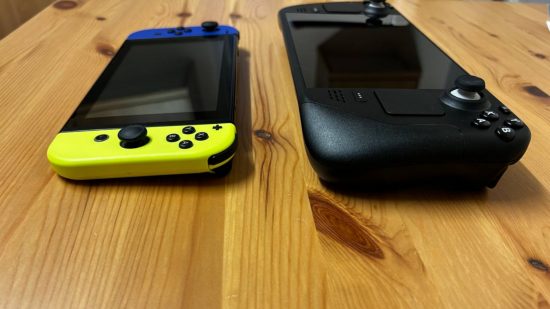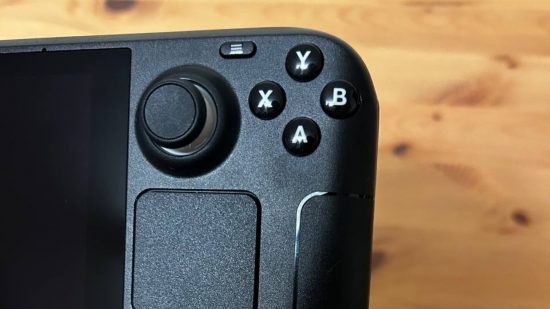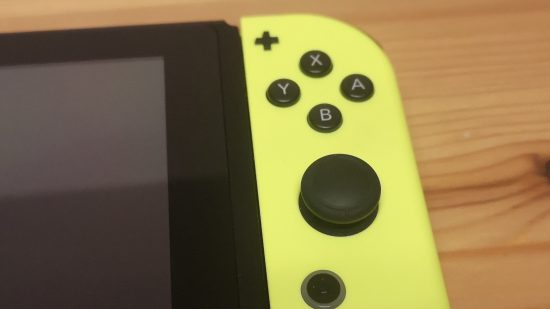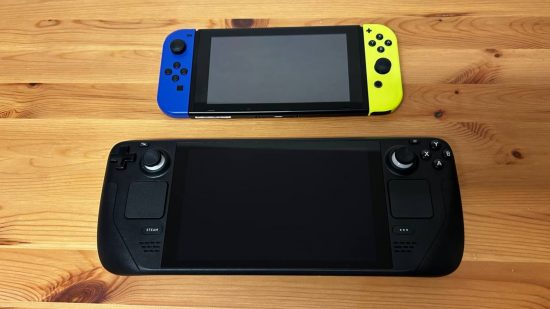Nintendo Switch vs Steam Deck – the very fact that this debate exists shows that it’s the perfect time to be a fan of handheld gaming. Between these two giants, practically every game in the history of gaming is available to play on the go. Though from an outside perspective, we can understand that some people might struggle to identify the unique benefits of each one.
These are two of the best portable gaming consoles to ever exist, outdoing even the best gaming phone. If curling up on the sofa with a console in your hand is your idea of the perfect night, both the Nintendo Switch and Steam Deck are good options. However, there are some key differences between the two that may mean one is more suitable than the other. But we’re here to look at what makes them different, covering things such as price and their respective library of games.
Before getting started, you might want to read our Steam Deck review and our Nintendo Switch review – they give you a lot of detail on each device individually. Click below to jump to different areas of comparison for the two consoles:
Pricing
It’s fair to say that the majority of people will first take notice of the price discrepancy between the two. The Nintendo Switch is considerably cheaper than the Steam Deck, with the standard model retailing for around $300 (£259.99). In contrast, the cheapest option for the Steam Deck still comes in at $399 (£349), meaning that if you go with the best Nintendo Switch console, you can save yourself at $90 (£90). With that in mind, the Nintendo Switch is certainly the better option if you’re on a budget.
Both the Steam Deck and Nintendo Switch boast three different versions; a base version, cheaper version, and a more premium option. Of course, numerous factors determine why each console falls into one of those three brackets. Allow us to break it down for you with a comparison of the three types.
Cheapest Switch and Steam Deck
The cheapest Switch, the Switch Lite, comes in at $199.99 (£199.99) and is a handheld device only, meaning you can’t dock it and play games on your TV. Read our Switch Lite review for more information.
As for the Steam Deck, its cheapest option is $399 (£349), and teh reason it costs less than other Steam Deck models is that it only has 64GB of eMMC memory, but that is double the amount that the Switch Lite has.
Standard Nintendo Switch and Steam Deck
The standard Switch costs $300 (£259.99), can be played both handheld or docked, and has 32GB storage capacity, just like the Switch Lite. At $529 (£459) the standard Steam Deck has 256GB of NVMe SSD storage space, which is both more space, and also faster than eMMC.
Premium Nintendo Switch and Steam Deck
Finally, the premium Switch model is the OLED. Without question, it’s the best Nintendo Switch console; it boasts 64GB of storage space, features a larger OLED screen that enhances handheld play (but not docked), and costs $349.99 (£309.99), which makes it considerably more cost-effective than the premium Steam Deck model. Read our Nintendo Switch OLED review for more information.
As for the premium Steam Deck model, which costs $649 (£569), it has 512GB NVMe SSD storage space meaning it’s capable of storing and running many of those big games you love. Plus, it has anti-glare etched glass, making it easier for you to see the screen while outside.
While that gives you a rough idea of the price differences of each console, and of a few of the features that justify those price differences, it’s also worth noting that the Steam Deck is a much more powerful device than the Switch, and we’ll get into that more when we discuss the specs below.

Games library
The Nintendo Switch has an extensive library of games, including Pokémon games, Zelda games, Mario games, and Animal Crossing games, while boasting titles from IPs such as Xenoblade and Fire Emblem. All this goes to say that Nintendo has a mighty impressive catalog of first-party franchises at its disposal, and as they’re first-party, they’re also exclusive to the Nintendo Switch.
For many people, that alone is a reason to get a Nintendo Switch. Better still, you’ve got access to a bit of everything – a huge library of indie games, various retro console classics, big games like Minecraft, Skyrim, The Witcher III, Crash Bandicoot, and popular multiplayer games like Fortnite or Fall Guys.
While the Switch lacks huge next-gen releases such as Elden Ring, it still gets a lot. Most gamers won’t have trouble finding a long list of games that they’d like to play on the console. Read our list of the best Nintendo Switch games to discover our top picks and get a taste of what’s on offer.
The Steam Deck also has an enormous library of games. Like the Nintendo eShop, there’s a huge selection of quality indie and retro games. Although, unlike the Nintendo eShop, the Steam Deck can also run big next-gen games like Marvel’s Spider-Man and Elden Ring. It’s a more powerful piece of hardware, and this expanded selection of games reflects that.
Mind you, there’s no (legitimate) way to play anything from Nintendo’s own back catalog on the Steam Deck, and that can be enough to turn people away from Valve’s handheld. It’s also important to note that not every game on Steam is compatible with the Steam Deck, so there’s a chance you can actually play one of the games that you want to unless you sit at your PC. However, more and more games are being made compatible with the console, so it does have an ever growing library. Our sister site, PCGamesN, has a list of the best Steam Deck games that you can read for more details on its library.
Specs
It’s what’s on the inside that counts – or maybe just the stuff you’re made of overall. Here’s a comparison of several of the main components of both the Steam Deck and Switch:
- Screen: The Steam Deck has a 7-inch LCD screen, which is larger than the standard Switch’s 6.2-inch LCD screen, and equal in size, but less visually impressive than the OLED’s 7-inch OLED display.
- Battery life: The Switch can last up to about 6.5 hours (9 hours if you use an OLED), while the Steam Deck can last for about 8 hours. Considering that the Steam Deck will use so much more processing power on that battery life, they’re pretty evenly matched.
- CPU/GPU: The Steam Deck uses an AMD Zen 2 CPU, along with an AMD RDNA 2 GPU, while the Switch uses an ARM Cortex-A57 CPU with an Nvidia Maxwell GPU. What does that mean? Essentially, the Steam Deck can handle games with better graphics that have much more intense action on-screen than the Switch can – by quite a significant margin too.
- Refresh rate: They both boast 60Hz, putting on an equally impressive footing in this regard.
- Storage space: As mentioned above, you get a maximum of 64GB on Nintendo’s handheld (though you can easily expand this with the best micro SD card for Switch), whereas the Steam Deck can give you 512GB and still have room for expansion. Keep in mind, though, that some Steam games are really big, whereas Switch games are typically a lot smaller, so you can still fit a lot more than you might think on a 64GB console.
Ultimately, the Switch was released in 2017 and hasn’t seen a significant update since, as even the OLED features much of the same hardware, whereas the Steam Deck was released in 2022 and designed to run more powerful games than the Switch (it’s essentially a portable gaming PC). The Nintendo Switch is a great bit of kit to own, but we can’t deny that it can’t compete against the Steam Deck on a technical level.

Ease of use
Do you want to be able to take your console out of the box and get started right away? Is your level of technical expertise relatively low? Do you not have the patience for a long set-up process? If so, the Nintendo Switch is probably going to be the console for you.
When you first turn it on, you need to choose your system language and your time zone, and that’s pretty much it. You make a really simple profile that involves little more than a name and an avatar picture, then you can just put a cartridge in and start playing within five minutes. Unless you don’t have a cartridge for your game, in which case you need to wait for your game to download.
The Steam Deck, meanwhile, requires much more time to get it set up properly. You have to connect it to your Steam account, you have to download your games as, unlike the Switch, you can’t use cartridges, you have to configure the controls for the games (which is even trickier if you’re using a separate controller), and several other things.
If you’re buying this for a young child, or it’s for yourself and you don’t have a lot of experience with things like that, the set-up process is going to be time-consuming.
The benefit to the Steam Deck being more complex to set up is that it means you can customize its settings to better suit your style of play. On the Steam Deck, you can remap buttons as you see fit, making it that much easier to navigate your favorite games. Better still, using third-party controllers is so much easier with the Steam Deck than the Switch.
Meanwhile, if you know your way around a gaming PC, you can make use of fan-made mods of your favorite games and even use emulators for other platforms (two things Nintendo would never allow). So, basically, the Steam Deck is harder to use, but it can do a lot more.
Multiplayer options
For some, gaming is an activity for two or more people, and if that’s you, we have no doubt you want to know more about the multiplayer options for the Switch and Steam Deck. When it comes to the Nintendo Switch, depending on if you picked up a game like Mario Kart 8 Deluxe with your console, you can jump into multiplayer action immediately, as there are two joy cons that come with the Switch, and each player can use one for some multiplayer fun. You can even do this in handheld mode, making it a great console to take with you on roadtrips and the like.
You can also make use of local multiplayer on the Steam Deck, but it doesn’t have as many games with this option as the Switch. Furthermore, you need to check games on Steam to see if they’re tagged as featuring local multiplayer. Even then, you can’t jump straight to it like you can with the Switch. Instead, you need to have two controllers and prepare yourself for the fact that some multiplayer games on console aren’t on Steam.
On the flip side, what about those who prefer online play to local multiplayer? Nintendo is very aware that many of its users are children, and so it goes to great lengths in order to protect them from predators and other malicious people on the internet – this is very admirable, but it does mean that even things like sending messages to your friends through the Switch are impossible. If you want to enjoy voice chat, you have to download the Nintendo Switch app and do it through that (and at that point, why not just use a dedicated app for voice or video calls?)
Steam Deck places no limitations on your online communications. In fact, you can even install Discord and then easily switch between it and your games at any point. Meanwhile, with games like Halo Infinite and Sea of Thieves available on Steam and Steam Deck compatible, you’ll have a much larger selection of online games to enjoy with your friends too.

Portability
The Steam Deck and the Nintendo Switch are both handheld consoles, so it’s reasonable to assume that you might want to play them on the go. Still, which of these two devices is better to carry and play while on the go?
Well, to be honest, they’re both massive. I don’t think either of them does a good job of being a conveniently sized handheld device that you can just slip in and out of your pocket (I miss the Nintendo 3DS). If you want to bring one of them with you, you need to bring a bag.
However, I must admit that the Nintendo Switch feels less bulky than the Steam Deck and is much lighter to hold, making it a bit better for those longer gaming sessions. If you have the Nintendo Switch Lite, it’s arguably the best of the lot for portability. Though I don’t mean to suggest that it has never happened (because it definitely has), I have never seen anyone playing a Steam Deck out in public, but I see people playing Switches in public quite a lot.
Streaming services
For many, their gaming console is their home entertainment center – a place where they can listen to music, watch their favorite movies and TV shows, and play videogames. With a handheld console in particular, isn’t there something quite appealing about curling up in your bed and watching your comfort show after a hard day?
On this front, Nintendo falls flat. Netflix, Disney Plus, Amazon Prime Video, and pretty much all of the major streaming services are absent from the Switch, with no native app that allows them to be viewed through the console.
You’re only option here is to watch YouTube, Crunchyroll (so it is good for anime fans), or Twitch, and the Pokémon anime through a map Nintendo has specifically designed for it, but that’s all you have access to, many people like to watch things beyond anime and streamers.
Admittedly, Steam Deck does also lack native apps for the big streaming services, but that doesn’t really matter, because the level of control and customization you have with a Steam Deck means that you can get them up and running on there in no time.
Final verdict
- Buy the Steam Deck if… you want a more powerful handheld gaming PC.
- Buy the Nintendo Switch… if you want an easy-to-use portable console and enjoy the rich catalog of Nintendo games.
Based on pure technical prowess, the Steam Deck blows the Nintendo Switch out of the water. It’s a really impressive device that puts all the power of a gaming PC into your hands. With this, it’s easy to play next-gen Steam games on your television, while also giving you the option to use fan-made mods, emulators, and much more. If you want to do something specific on the Steam Deck, the chances are that you will be able to do so – if you know how.
If you want to play on the Nintendo Switch, you don’t really need to have any level of technical expertise beyond the most simple things. You pop in a game and you play. That’s it.
While there’s no denying that Switch games may not require the same level of processing power to play, Nintendo once again proves that a game doesn’t need to push the envelope (technically) in order to be good, with games like The Legend of Zelda: Tears of the Kingdom, Fire Emblem: Three Houses, and Super Smash Bros. Ultimate offering incredible experiences… but it still misses out on next-gen smash hits like Elden Ring, Starfield, and Marvel’s Spider-Man.
So if you want a handheld device that can do anything, and you don’t mind paying a bit more and putting in a little bit of extra effort to get it up and running just as you want it to, go for the Steam Deck. If you’re a fan of Nintendo and its rich back catalog and want to be able to play its games (and countless others from the past 30 years of gaming) easily and conveniently (without having to spend too much), we think you should go for the Nintendo Switch.
Our Steam Deck vs Asus Rog Ally guide might be another handy point of reference if you’re considering buying a platform but are specifically interested in taking your PC gaming on the go. We’ve also got a bit of Steam Deck 2 speculation that you’ll want to check out.
